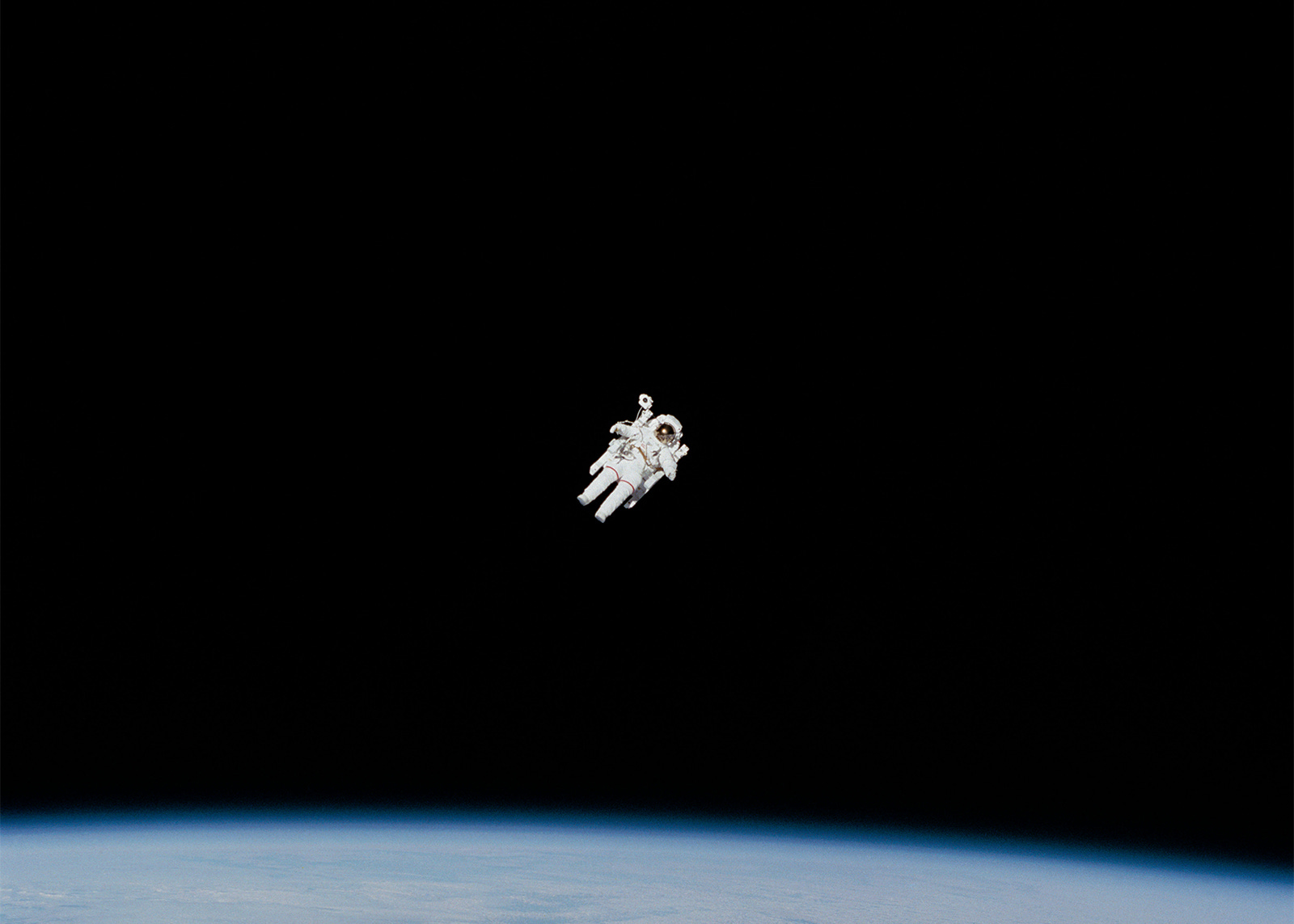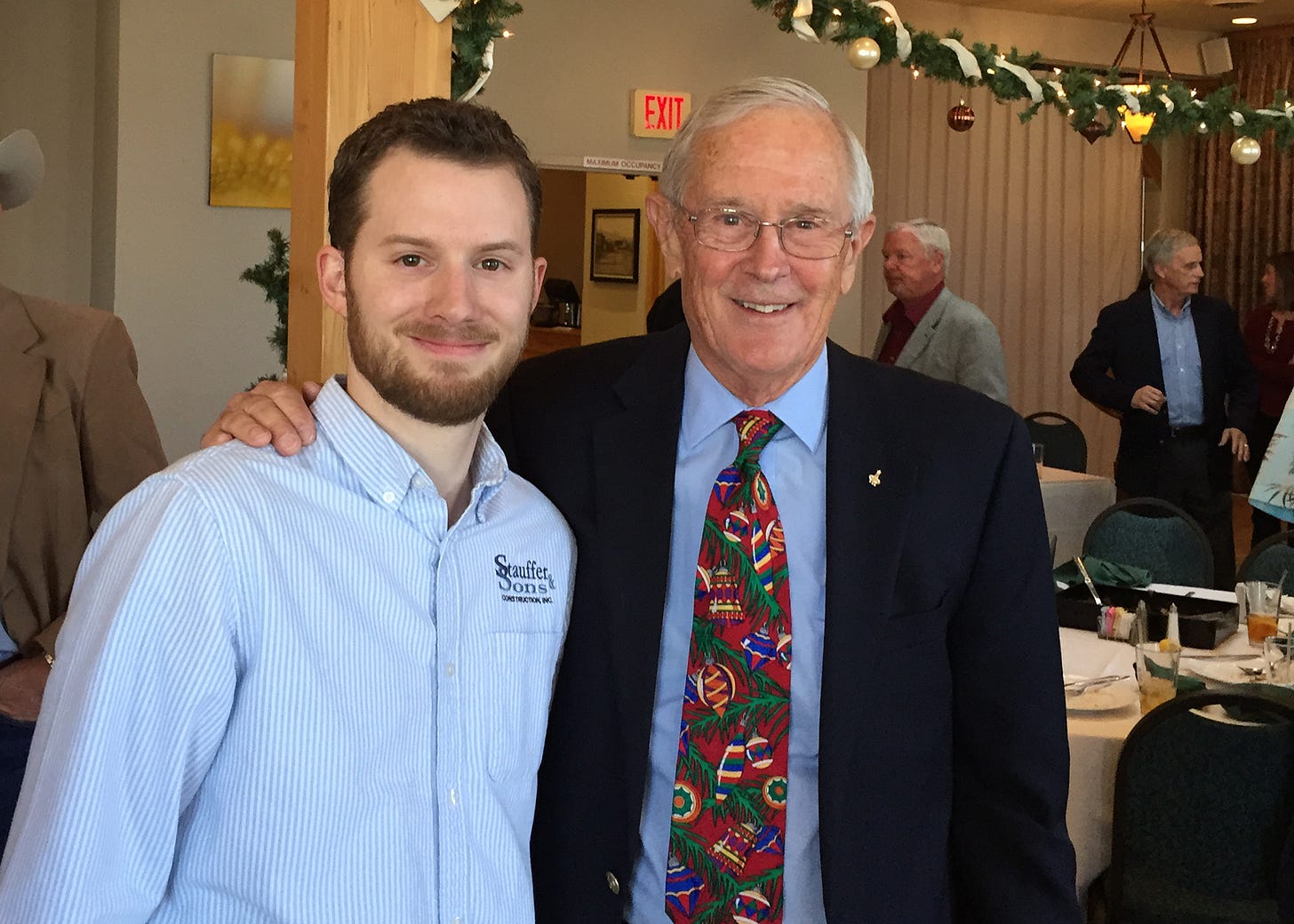A Word on Space, From a Man Who Walked On the Moon
Ignore the idiot science guy on Earth; listen to the smart space guy who actually saw Earth himself from outer space
Last month, NASA released one of the most astonishing photographs I’ve ever seen in my entire life. Without exaggeration, staring at this picture of a man performing an “untethered spacewalk”—the first of its kind—is enough to stop my breath.
I may have seen this photo before, but if so, I wasn’t really paying attention. This version, however, is high enough in resolution and detail that I just can’t stop looking at it and marveling at the sight.
What I noticed most when I saw this picture shared by the NASA History Office on Twitter/𝕏, though, wasn’t the picture itself but the quote shared along with it.
“We are just a speck, on a speck, orbiting a speck, in the corner of a speck, in the middle of nowhere.”
This quote from “Bill Nye The Science Guy” was a very strange choice to include here.
It’s especially jarring when juxtaposed with the associated image because the more you look at the picture, the less it makes sense.
Bill Nye, the narcissist, self-proclaimed expert, and recently-minted political activist who spends his days touting bizarre gender pseudoscience, with his pronouncement here, is clearly trying to convince people of just how small and insignificant Man is.
He wants us to believe that humans are very tiny, incidental accessories accidentally floating among a collection of cosmic detritus, nowhere, for absolutely no reason at all.
We weren’t placed here, we don’t belong here, and it’s all meaningless. Not even Carl Sagan was this nihilistic with his “Pale Blue Dot” commentary.
But looking at the picture itself, his argument has absolutely zero logic: the words don’t match the image at all—they even stand in stark contrast with it.
Seeing astronaut Bruce McCandless II floating alone in space with Earth in the background, to me, shows just how incredible and meaningful Man is.
Nye wants us to look at Man in and conclude: “Look at how tiny we are. Look at how unimportant we are. Actually, look at how tiny and unimportant it all is.”
This is foolishness.
When I was growing up, I occasionally watched Nye on PBS. I thought he was kind of funny, and he made science interesting and accessible. But as I got older, I realized that he isn’t much of a “Science Guy” at all.
In the 2020s, he’s turned into an angry clown, fighting for continued relevance by cashing in on his former celebrity as a TV personality out of desperation.
Also, for someone whose entire persona revolves around his expertise, Nye’s extremely average Bachelor of Science in Mechanical Engineering really pales in comparison to a lot of other, more qualified “science guys.” You know, intellectual giants such as:
Hans “Dolf” Lungren (Master of Science and actor)
Tom Scholz (Master of Science and lead guitarist from Boston)
Brian May (PhD and lead guitarist from Queen)
Rowan Atkinson (Master of Science and actor)
Many, many people on this supposedly small, insignificant Earth are more qualified to proclaim themselves experts than Bill Nye. That’s right: Ivan Drago and Mr. Bean are more qualified men of science than the “Science Guy” himself.
Rather than listen to the fake science guy with a dismal view of humanity, here is a much better perspective on the significance of Man, the Earth, and the universe from a man who actually went into outer space and literally walked on the Moon, looked back at the Earth and was astonished at how significant it all was.
U.S. Air Force fighter pilot, brigadier general, and astronaut Charles Moss Duke Jr. (“Charlie Duke”) flew to outer space on a rocket ship, walked on the Moon, drove around on a Lunar Roving Vehicle and collected Moon rocks.
I met General Duke a few years ago and got to hear a first-hand account of his Apollo 16 trip. Here is a small excerpt of what he learned when he left Earth to explore the celestial bodies.
(Read his quote below or press the play button to hear the words in his own voice).
We shook our way into orbit, and two and a half hours later, over Australia, we accelerated to what was called “escape velocity,” which was about 25,000 miles an hour, and we were on our way to the Moon.
A few moments later, we turned our spaceship around and [Thomas “Ken”] Mattingly said, “Look at this!” and we floated over to the left side, and as you got up to the window, which was about the size of a basketball, I looked out and it was the most awesome sight I’d ever seen.
Sixteen thousand miles away was the whole circle of the Earth… breathtakingly beautiful.
Our view of Earth was all of North America, and we could see the Arctic Circle and the North Pole. The upper Arctic Circle area was all pure white with the snow and the clouds, and you could see the whole of the United States, and it was brown in color and so was Mexico and Central America.
But it didn’t look inhabited from 16,000 miles, you couldn’t see any evidence of civilization, couldn’t see Los Angeles, or Chicago or Denver or Colorado Springs or Houston… [or] Mexico City. It was nothing to indicate civilization.
But there was a beauty about the Earth, the brownness of the land and the crystal blue of the water, and there was this—what I call “the Jewel of Earth”—hung in the blackness of space.
In the book of Isaiah1 there’s a little phrase in the 40th chapter that says, “God sits enthroned above the circle of the Earth.”
Now, I didn't see God enthroned, but I saw the circle of the Earth.
In the book of Job2 it says, “When God made the Earth, he suspended it upon nothing,” and that’s exactly what it looks like. This jewel—the Earth—hung in the blackness of space…. [it] hung upon nothing.
And as I read those words, the thought occurred to me: “Who told those guys it was a circle?” Those words were written 2,800 years ago, plus or minus a few. Isaiah had never seen it with his own eyes. [In] 1961 Man for the very first time saw it with his own eyes, as a circle.
So… the men didn’t know, but God knew. And God spoke it into the hearts of these men who recorded it, and it has been carried down through the centuries.
Now, on the way to the Moon, I didn’t realize any of that, and I wasn’t contemplating, “the heavens declare the glory of God; the skies proclaim the works of His hands.3” That wasn’t part of my thoughts in those days. I just wanted to get to the Moon.
…and we made it to the Moon. John [Young] and I landed on the Moon in a place called Descartes, which as you the look at the Moon it was right in the middle of the full Moon. It was an awesome experience to be there, to bounce around in that light gravity, to look out across this—now I know—is the creation of God as he spoke it in existence.
…and to see the mountains to the left five miles away and the mountains to the right, we were at the top of the mountains of the Moon and it was incredible.
As I looked out across the horizon to the west it was open—a valley—and you could see the curvature of the Moon and this gray rolling terrain, and you look up into the sky and the sky was just jet black.
Though the sun was shining, it was just blackness.
And by bending your spacesuit way back, I could look directly over my head and there was the Jewel of Earth 230,000 miles away, “our Island Home,” as some people have called it.
That’s just a small excerpt of his experience, but it’s powerful.
If you’re interested in outer space, you can browse the recently released pictures from the NASA History Office on their website. But don’t be despondent at the smallness of humanity; be inspired by the majesty of creation, which includes Man, Earth, the Sun, our galaxy, and the universe.
I don’t look at this image and conclude: “We are just a speck, on a speck, orbiting a speck, in the corner of a speck, in the middle of nowhere.”
I look at this image and conclude: “We are fearfully and wonderfully made, created in the image of the same God who also made the heavens and the Earth and holds them in His hands, and we are right at home, exactly where we belong, in the center of everything, and we matter a great deal.”
By the way, in case it matters, General Duke also has a Bachelor of Science degree just like Mr. Fancy Pants Science Guy… as well as a Master of Science. So… there’s that.
On a final note, as I went to publish this, I noticed that NASA deleted their original Tweet with the photo. They also removed the quote from their Facebook post of the same image. I’m not sure why they did (I can’t find any explanation), but I find that a fascinating—and positive—development.
‘He sits enthroned above the circle of the earth, and its people are like grasshoppers. He stretches out the heavens like a canopy, and spreads them out like a tent to live in.’ Isaiah 40:22
‘He spreads out the northern skies over empty space; he suspends the earth over nothing.’ Job 26:7
‘The heavens declare the glory of God; the skies proclaim the work of his hands.’ Psalms 19:1






Bravo!
I was a 6-year-old kid when I got to see Apollo 16 blast off standing on the top of a Buick station wagon. It was the most literally awesome experience of my life.
I still feel like a little kid when I look at that photo!
It’s too bad that the American public grew bored of space so quickly. Now, shaving a millimeter off the thickness of a cellphone or an algorithm that addicts our kids to social media are what people think of as “technology“.